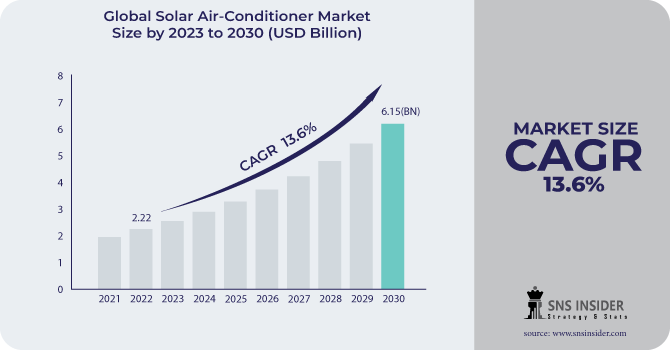Solar Air-Conditioner Market Report Scope & Overview:
The Solar Air-Conditioner Market size was valued at USD 2.22 billion in 2022 and is expected to grow to USD 6.15 billion by 2030 and grow at a CAGR of 13.6 % over the forecast period of 2023-2030.
An air conditioner powered by solar energy. These air conditioners operate similarly to conventional air conditioners, with the exception that they provide more energy choices. Typically, an air conditioner Solar air conditioners are solely powered by grid electricity and provide three power sources: solar power, solar battery storage, and network electricity.

To Get More Information on Solar Air-Conditioner Market - Request Sample Report
The actual design and functioning of a solar air conditioner are simple. It is designed to allow the AC to be connected directly to a solar panel and take power from it. Solar panels take in light and convert it to direct current (DC) power. The air conditioner is powered by the energy produced.
The primary factor influencing a buyer's choice is the Solar AC pricing in India. In general, a solar air conditioner's price depends on a number of factors, including its sort, company, volume, and quality.
MARKET DYNAMICS
KEY DRIVERS:
-
Growing demand for solar air conditioning
-
Increasing comfort among peoples
-
Rising adoption of solar air conditioning system
RESTRAIN:
-
High Initial Cost
OPPORTUNITY:
-
Increasing government initiatives
-
Developing innovations in solar air conditioning
-
Decision-making through various strategies
Rising electricity rates and the increasing need to reduce energy consumption which is turn boosts the market of solar air conditioners market.
CHALLENGES:
-
Rising concern about climate change and its impact on human health
IMPACT OF ONGOING RECESSION
According to an analysis by the Solar Energy Industries Association, solar capacity in the United States increased by roughly 9%, or 1,265 megawatts, to 8,775 megawatts last year. The yearly report will be made public. As more solar water heaters were installed, the capacity of solar panels increased by 78% raised SO percentage. But exports of solar pool heating decreased by 3% as a result of the housing crisis systems, the sector's largest subgroup in terms of capacity. Some solar enterprises are experiencing financial difficulties as a result of the crisis, the organisation Although customers continue to show interest in solar.
KEY MARKET SEGMENTATION
By Product Type
-
Split Solar A/C
-
Window Solar A/C
-
Cassette Solar A/C
-
Floor Standing Solar A/C
By Power Source
-
Hybrid Solar A/C
-
100% Grid off A/C
By End User
-
Residential
-
Commercial
-
Industrial
.png)
Do You Need any Customization Research on Solar Air-Conditioner Market - Enquire Now
REGIONAL ANALYSIS
Asia Pacific is anticipated to have the largest market share for solar air conditioning throughout the anticipated period. Demand in this market is anticipated to be driven by higher economic development, which increased personal disposable income. In developing nations, consumers are more prepared to pay more for the utility good that might increase demand for solar air conditioners. High demand for solar air is another factor. Conditioners are also used by small and medium-sized businesses, which has helped this industry grow.
REGIONAL COVERAGE:
North America
-
US
-
Canada
-
Mexico
Europe
-
Eastern Europe
-
Poland
-
Romania
-
Hungary
-
Turkey
-
Rest of Eastern Europe
-
-
Western Europe
-
Germany
-
France
-
UK
-
Italy
-
Spain
-
Netherlands
-
Switzerland
-
Austria
-
Rest of Western Europe
-
Asia Pacific
-
China
-
India
-
Japan
-
South Korea
-
Vietnam
-
Singapore
-
Australia
-
Rest of Asia Pacific
Middle East & Africa
-
Middle East
-
UAE
-
Egypt
-
Saudi Arabia
-
Qatar
-
Rest of Middle East
-
-
Africa
-
Nigeria
-
South Africa
-
Rest of Africa
-
Latin America
-
Brazil
-
Argentina
-
Colombia
-
Rest of Latin America
KEY PLAYERS
The Major Players are Lennox, Aussie Solar World, ICESolair, Videocon, HotSpot Energy, Solair World International, Gree, Midea, Haier, Midea group Onyx Solar ac, and other players are listed in a final report.
Videocon-Company Financial Analysis

| Report Attributes | Details |
| Market Size in 2022 | US$ 2.22 Bn |
| Market Size by 2030 | US$ 6.15 Bn |
| CAGR | CAGR of 13.6 % From 2023 to 2030 |
| Base Year | 2022 |
| Forecast Period | 2023-2030 |
| Historical Data | 2020-2021 |
| Report Scope & Coverage | Market Size, Segments Analysis, Competitive Landscape, Regional Analysis, DROC & SWOT Analysis, Forecast Outlook |
| Key Segments | • By Product Type (Split Solar A/C, Window Solar A/C, Cassette Solar A/C, Floor Standing Solar A/C) • By Power Source (Hybrid Solar A/C, 100% Grid off A/C) • By End User (Residential, Commercial, Industrial) |
| Regional Analysis/Coverage | North America (US, Canada, Mexico), Europe (Eastern Europe [Poland, Romania, Hungary, Turkey, Rest of Eastern Europe] Western Europe] Germany, France, UK, Italy, Spain, Netherlands, Switzerland, Austria, Rest of Western Europe]). Asia Pacific (China, India, Japan, South Korea, Vietnam, Singapore, Australia, Rest of Asia Pacific), Middle East & Africa (Middle East [UAE, Egypt, Saudi Arabia, Qatar, Rest of Middle East], Africa [Nigeria, South Africa, Rest of Africa], Latin America (Brazil, Argentina, Colombia Rest of Latin America) |
| Company Profiles | Lennox, Aussie Solar World, ICESolair, Videocon, HotSpot Energy, Solair World International, Gree, Midea, Haier, Midea group Onyx Solar ac |
| Key Drivers | • Growing demand for solar air conditioning • Increasing comfort among peoples • Rising adoption of solar air conditioning system |
| Market Restraints | • High Initial Cost |

